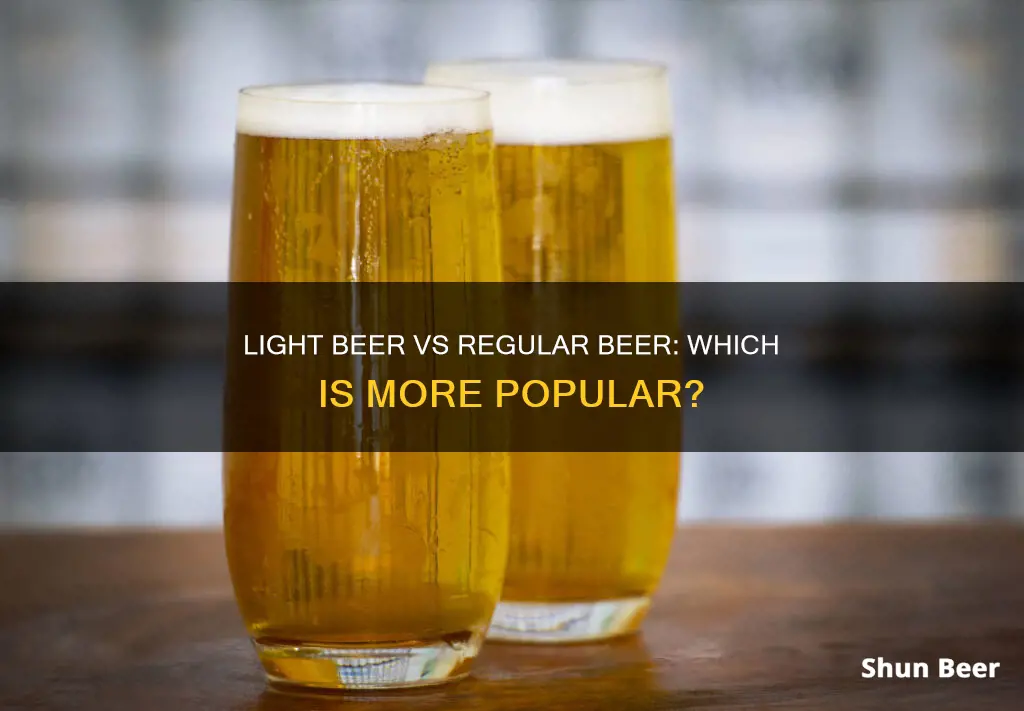
Light beer is the bestselling beer style in America, with Bud Light, Miller Lite, Coors Light, and Michelob Ultra making up the top four draft beer sales in 2019. However, light beers are often criticised for their lack of flavour and higher price tags. So, which is more popular: light beer or regular beer? This comparison will consider sales, taste, and health to determine which type of beer is preferred by the majority.
| Characteristics | Values |
|---|---|
| Popularity | Light beer is the best-selling beer style in the US, with light beers making up the top four of draft beer sales at the close of 2019. |
| Taste | Light beers are criticised for tasting like "pool water" or beer-flavoured water, however, they are also considered to be lighter, crisper, and less filling than regular beers. |
| Calories | Light beers have fewer calories than regular beers, with an average of 103 calories per 12-ounce serving compared to 150 calories or 153 calories in regular beer. |
| Carbohydrates | Light beers have lower levels of carbohydrates, cutting the carb count by more than half compared to regular beer. |
| Alcohol Content | Light beers have a lower ABV (alcohol by volume) than regular beers. |
| Price | Light beers are often more expensive than regular beers. |
What You'll Learn

Light beer is the bestselling beer in the US
Light beer is the bestselling beer style in the US. Despite the massive changes in the American brewing scene over the past two decades, light beer has remained the top-selling beer style in the country. In 2018, the three best-selling beers by volume were light beers: Bud Light, Coors Light, and Miller Lite. Together, they topped 53 million barrels sold. At the close of 2019, light styles were responsible for 48.5% of the "pour volume" nationwide.
Light beer is a beer, usually a pale lager, that is reduced in alcohol content or calories compared to regular beers. Light beers are chosen by drinkers who want to manage their alcohol or calorie consumption. They are, however, often criticised for being less flavourful than full-strength beers, or for tasting watered down. Light beers are also usually more expensive than regular beers.
The popularity of light beer in the US can be traced back to the temperance movement of the 19th and 20th centuries, which sought to reduce or eradicate alcohol consumption. Beer was marketed as a "temperance beverage", and lighter beers were seen as less intoxicating. The Bohemian pilsner, which was clearer, lighter, and blander than previous lagers, became popular during this time. The lager's light colour and mild taste appealed to Americans, and it was also a good fit for the long hours of American factory workers, who often drank beer between shifts.
The popularity of light beer continued to grow after Prohibition, with the new, watered-down beer becoming a huge hit with the public. The blandification of American beer continued for another 70 years, with the rise of "lite" beer in the 1970s further accelerating the trend. Despite the rise of craft beer, light beers remain the dominant style in the US.
Beer and Invisalign: What You Should Know
You may want to see also

Light beer is reduced in alcohol content and calories
The lower alcohol content in light beer allows consumers to drink more beers in a shorter period without becoming intoxicated. This is particularly appealing to those who wish to manage their alcohol consumption for medical, social, or legal reasons. Additionally, the reduced calorie content can be attractive to those conscious of their calorie intake.
Light beers are often criticised for having less flavour than full-strength beers or for tasting watered down. This is because reducing the calories in the beer often involves cutting down on ingredients such as hops or yeast, which can lead to a loss of flavour. Despite this criticism, light beers remain extremely popular in the United States, with some sources claiming they are the bestselling style of beer in the country.
The popularity of light beers may be due to their accessibility and the perception that they are a "healthier" option compared to regular beers. However, it is important to note that drinkers of light beer may consume more beers overall to achieve the same level of intoxication as regular beer, potentially negating the reduced-calorie benefit. Additionally, the "light" label is relative, and the calorie and carb counts can vary between different brands of light beer.
In conclusion, light beer is reduced in alcohol content and calories compared to regular beer, which can be achieved through various brewing techniques. This reduction has various benefits for consumers, but it is important to be aware of the potential drawbacks, such as increased consumption to achieve the desired level of intoxication.
IBS Medication and Beer: Is It Safe to Drink?
You may want to see also

Light beer is criticised for being less flavourful
Light beer has its fair share of critics, with many detractors claiming it tastes like "pool water" and is "watered down". It is often criticised for being less flavourful than full-strength beers.
The process of cutting calories in light beer often involves reducing or eliminating ingredients such as hops or yeast, which can lead to a loss of flavour. This results in a beer that tastes more like flavoured water than a full-bodied beer. Some critics have suggested that those who opt for light beer are not concerned with taste, but rather with managing their calorie intake or alcohol consumption.
However, it is worth noting that taste is subjective, and some people may prefer the lighter, crisper taste of light beer. While critics may turn their noses up at the lighter option, it has still managed to gain significant popularity, with light beers making up the top four draft beer sales in the US in 2019.
Despite the criticism, light beer has become a popular choice for many beer drinkers. Some people may prefer the lighter taste, while others may appreciate the option to manage their alcohol or calorie intake. Additionally, the lower ABV in light beer can allow drinkers to consume more beers in a shorter period without becoming intoxicated, which may be a desirable effect for some.
While light beer may be criticised for its lack of flavour, it is important to recognise that it fills a specific niche in the market and has gained a dedicated following, even if it is not to everyone's taste.
Beer and Comal River: What You Should Know
You may want to see also

Light beer drinkers may consume more beers overall
Some sources suggest that the lower alcohol content in light beers can be a reason for consumers to drink more. Light beers are typically counterpoints to another beer in a brewery's repertoire, with the same flavour profile but fewer calories and a lower ABV. This means that to achieve the same level of intoxication, a drinker may need to consume more light beers than they would regular beers.
The lower ABV of light beers can also influence the drinking experience. Some argue that the "feel-good effect" of alcohol is less efficient with light beers, leading to more consumption to achieve the desired level of intoxication. This can result in drinking more overall, as well as more trips to the bathroom due to increased urination.
Additionally, the lower calorie count of light beers may not always translate to a healthier option. While light beers have fewer calories than regular beers, this difference may not be significant enough to make a substantial impact on overall calorie intake, especially if more beers are consumed to achieve the desired level of intoxication.
The perception of light beers is evolving, with craft brewing companies joining the market and offering new options. However, the debate about their appeal continues, with some considering them a "gimmick" that compromises flavour for lower calories. Despite this, light beers remain extremely popular, with some of the top-selling beers in the US falling under this category.
Ocean City Beach: Drinking Beer, What's Allowed?
You may want to see also

Light beer is sometimes overpriced
Light beer is sometimes criticised for being overpriced. While light beer is often chosen by those who want to manage their alcohol or calorie consumption, it is sometimes seen as a gimmick, with critics claiming that it tastes like "pool water" and is not worth the price.
In terms of pricing, light beer is not always much cheaper than regular beer. For example, in New York City, a Bud Light can cost $6 or more, while craft beers are typically priced at $7 to $8. While buyers may save a small amount of money on each drink, they often end up consuming more to achieve the same level of intoxication, ultimately spending more than they would on regular beer.
The perception of light beer as overpriced may also be influenced by its flavour. Light beers are often criticised for having less flavour than full-strength beers, with some describing them as tasting watered down. By reducing the calorie content, brewers may inadvertently remove key flavour components, such as hops or yeast. This can result in a less satisfying drinking experience, even for those who prefer lighter, crisper beers.
Additionally, the lower alcohol content of light beers can lead to increased consumption. With a lower ABV (alcohol by volume), drinkers may need to consume more to feel the desired effects. This not only negates the potential calorie savings but can also result in a higher overall cost.
Despite the criticism, light beers remain extremely popular. In 2019, light beers from major brands like Bud Light, Miller Lite, Coors Light, and Michelob Ultra dominated draft beer sales, accounting for 48.5% of the "pour volume" nationwide in the United States. This popularity may be due to a combination of factors, including taste preferences, calorie consciousness, and the desire to manage alcohol intake. However, the perception of light beer as overpriced persists, particularly among those who prioritise flavour and value in their drinking choices.
Beer and Pancreatitis: What You Need to Know
You may want to see also
Frequently asked questions
Light beer is the best-selling style in the US. At the end of 2019, light beers made up 48.5% of draft beer sales nationwide.
Light beers are chosen by drinkers who want to manage their alcohol or calorie consumption.
Light beers have fewer calories and more than half the carbs of regular beers. However, drinkers of light beer may end up consuming more beers overall, which could mean they don't save many calories.
Light beers are sometimes more expensive, despite having less alcohol.
Light beers are often criticised for being less flavourful than regular beers, or tasting watered down.







